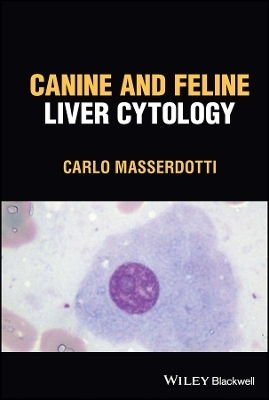
Canine and Feline Liver Cytology
Wiley-Blackwell (Verlag)
978-1-119-89554-1 (ISBN)
Canine and Feline Liver Cytology is a practical and highly illustrated manual with detailed descriptions of cytological features of hepatic diseases and numerous high-quality illustrations to aid in reader comprehension. The primary aim of the text is to describe the correlation of cytological findings with pathological processes in order to provide useful information to clinicians in management of hepatic diseases.
Canine and Feline Liver Cytology includes information on:
- General bases for interpretation of hepatic cytology, covering limits of cytology, value of cytology for a definitive diagnosis, and relationship with clinical data
- A specific reversible injury to hepatocytes, covering hepatocellular swelling, steroid induced hepatopathy, hepatocellular steatosis, and feathery degeneration
- Irreversible injury to hepatocytes, covering necrosis and apoptosis, and inflammation, covering neutrophilic, eosinophilic, macrophagic, and lymphoplasmacytic inflammation
- Intra and extracytoplasmic pathologic accumulation, covering lipofuscin, copper, iron, eosinophilic granules, protein droplet, bile, and amyloid
- Chronic hepatic diseases, with focus on cytological features of fibrosis
- Diseases of biliary tract and gallbladder
- Neoplastic diseases, covering epithelial, mesenchymal and round cell tumors
Canine and Feline Liver Cytology enables readers to interpret all the cytopathological changes in liver pathology and the relationship with clinical primary and secondary causes, eventually with histopathological diagnosis, making it a highly valuable resource for veterinary practitioners and students.
Carlo Masserdotti, DVM, Dipl ECVCP, Spec Bioch Clin IAT, Consultant, Anatomic and Clinical Pathology, IDEXX Laboratories, Brescia, Italy.
1 Before the analysis. Rules for interpretation of hepatic cytology
1.1 The rules for cytological diagnosis of hepatic diseases
1.1.1 Rule 1
1.1.2 Rule 2
1.1.3 Rule 3
1.1.4 Rule 4
1.1.5 Rule 5
1.1.6 Rule 6
1.1.7 Rule 7
1.2 Diagnostic approach to liver disease
1.2.1 Clinical and anamnestic signs
1.2.2 Hematochemical investigations
1.2.2.1 Pathological bases of liver damage
1.2.2.2 Diagnosis of liver damage
1.2.2.3 Useful enzymes for the recognition of damage to the hepatocyte and cholangiocyte
1.2.2.4 Liver failure diagnosis
1.2.2.5 Parameters of liver failure
1.2.3 Ultrasonographic investigation
1.2.4 Cytological and histopathological investigation
1.2.4.1 Sample collection
1.2.4.2 Cytological approach to hepatic diseases
1.3 To rimember
2 Normal Histology and Cytology of the liver
2.1 Normal liver histology
2.2 Normal cytology of the liver
2.2.1 Hepatocytes
2.2.2 Kupffer cells
2.2.3 Stellate cells
2.2.4 Cholangiocytes (biliary cells)
2.2.6 Hepatic mast cells
2.2.7 Hematopoietic cells
2.2.8 Mesothelial cells
2.3 To rimember
3 Non-specific and reversible hepatocellular damage
3.1 Accumulation of water
3.2 Accumulation of glycogen
3.3 Accumulation of lipids
3.4 Accumulation of bilirubin and bile salts
3.5 Hyperplasia of stellate cells
3.6 Regenerative changes
3.7 To rimember
4 Intra and extra-cytoplasmic pathological accumulation
4.1 Pathological intracytoplasmic accumulation
4.1.1. Lipofuscin
4.1.2 Copper
4.1.3 Iron and hemosiderin
4.1.4 Protein droplets
4.1.5 Cytoplasmic granular eosinophilic material
4.1.6. Hepatic lysosomal storage disorders
4.2 Pathological extracytoplasmic accumulations
4.2.1 Bile
4.2.2 Amyloid
4.3 To remember
5 Irreversible hepatocellular damage
5.1 Necrosis
5.2 Apoptosis
5.3 To remember
6 Inflammation
6.1 Presence of neutrophilic granulocyte
6.2 Presence of eosinophilic granulocytes
6.3 Presence of lymphocytes and plasmacells
6.4 Presence of macrophages
6.5 Presence of mast cells
6.6 To remember
7 Nuclear inclusions
7.1 “Brick” inclusions
7.2 Glycogen pseudo-inclusions
7.3 Lead inclusions
7.4 Viral inclusions
7.5 To remember
8 Cytological features of liver fibrosis
8.1 Cytological features of liver fibrosis
8.2 To remember
9 Cytological Features of biliary diseases
9.1 General features of biliary diseases
9.2 Cytological features of some specific biliary diseases
9.2.1 Acute and chronic cholestasis
9.2.2 Acute cholangitis
9.2.3 Chronic cholangitis
9.2.4 Lymphocytic cholangitis
9.3 To rimember
10 Bile and gallbladder diseases
10.1 Bactibilia and septic cholecystitis
10.2 Epithelial hyperplasia
10.3 Gallbladder mucocele
10.4 Limy bile syndrome
10.5 Biliary sludge
10.6 Neoplastic diseases of gallbladder
10.7 Other gallbladder diseases
10.8 To remember
11 Ethiological agents
11.1 Virus
11.2 Bacteria
11.3 Protozoa
11.4 Fungi
11.5 Parasites
11.6 To remember
12 Neoplastic lesions of the hepatic parenchyma
12. 2 Nodular lesions of epithelial origins
12.2.1 Nodular hyperplasia
12.2.2 Hepatocellular adenoma
12.2.3 Hepatocellular carcinoma
12.2.4 Cholangioma
12.2.5 Cholangiocellular carcinoma
12.2.6 Other nodular lesions of biliary origins
12.2.7 Hepatic carcinoid
12.2.8 Hepatoblastoma
12.3 Nodular lesions of mesenchymal origin
12.3.1 Malignant mesenchymal neoplasms
12.4 Nodular lesions of hematopoietic origin
12.4.1. Myelolipoma
12.4.2. Large-cell hepatic lymphoma
12.4.3 Small cell lymphoma
12.4.4. LGL lymphoma
12.4.5 Epitheliotropic lymphoma
12.4.6 Other types of hepatic lymphoma
12.4.7. Malignant histiocytic neoplasms
12.4.8. Mast cell tumor
12.4.9 Hepatic splenosis
12.5 Liver metastasis
12.6 Criteria for the selection of sampling methods of liver nodular lesions
12.7 To remember
| Erscheinungsdatum | 21.09.2023 |
|---|---|
| Verlagsort | Hoboken |
| Sprache | englisch |
| Maße | 158 x 231 mm |
| Gewicht | 590 g |
| Einbandart | gebunden |
| Themenwelt | Veterinärmedizin ► Großtier |
| ISBN-10 | 1-119-89554-5 / 1119895545 |
| ISBN-13 | 978-1-119-89554-1 / 9781119895541 |
| Zustand | Neuware |
| Haben Sie eine Frage zum Produkt? |
aus dem Bereich


